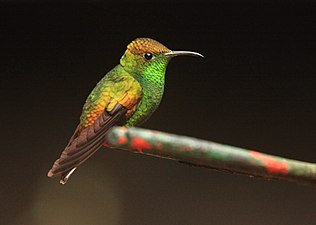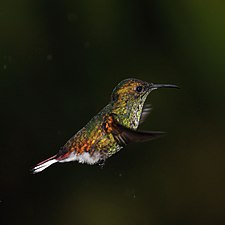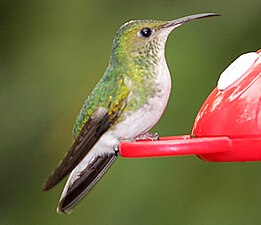Coppery-headed emerald
| Coppery-headed emerald | |
|---|---|

| |
| Scientific classification | |
| Kingdom: | Animalia |
| Phylum: | Chordata |
| Class: | Aves |
| Order: | Apodiformes |
| Family: | Trochilidae |
| Genus: | Microchera |
| Species: | M. cupreiceps
|
| Binomial name | |
| Microchera cupreiceps (Lawrence, 1866)
| |

| |
| Range of M. cupreiceps | |
The coppery-headed emerald (Microchera cupreiceps) is a small hummingbird endemic to Costa Rica. It measures a mere 3 in (7.6 cm) in length, and weighs only 3 g (0.11 oz).[2] The male has distinctive coppery crown and rump with a whole green belly and white vent. The female has a white belly and a narrow black subterminal band on white outer rectrices of the tail. Its noticeably decurved bill sets it apart from similar the allopatric white-tailed emerald.
This species is fairly common at middle elevations on Caribbean Slope, south to Reventazon River; from 600 to 1,500 m (2,000 to 4,900 ft). Also it is fairly common on Pacific slope of Guanacaste and Tilarán Cordilleras; from 1,200 to 1,500 m (3,900 to 4,900 ft).
Like all hummingbirds, the coppery-headed emerald feeds on nectar and small invertebrates. Because its bill is short, it forages at small flowers, including those in the genera Besleria, Cavendishia, Clusia, Guarea, Pithecellobium, Quararibea and Satyria.[2] It feeds at all levels in mature wet montane forest and forest edges.
Males form small leks at middle levels of forest edges.
The coppery-headed emerald was formerly placed with the white-tailed emerald in the genus Elvira. A molecular phylogenetic study published in 2014 found that these two species were closely related to the snowcap in the monospecific genus Microchera.[3] The three species were therefore placed together in Microchera which has priority.[4]

male
female, near Monteverde, Costa Rica

male, Cinchona, Costa Rica
References[]
- ^ BirdLife International (2012). "Elvira cupreiceps". IUCN Red List of Threatened Species. 2012. Retrieved 26 November 2013.
- ^ a b Henderson, Carrol L.; Adams, Steve (2002). Birds of Costa Rica: A Field Guide. Austin, TX: University of Texas Press. p. 160. ISBN 978-0-292-71965-1.
- ^ McGuire, J.; Witt, C.; Remsen, J.V.; Corl, A.; Rabosky, D.; Altshuler, D.; Dudley, R. (2014). "Molecular phylogenetics and the diversification of hummingbirds". Current Biology. 24 (8): 910–916. doi:10.1016/j.cub.2014.03.016. PMID 24704078.
- ^ Gill, Frank; Donsker, David; Rasmussen, Pamela, eds. (July 2020). "Hummingbirds". IOC World Bird List Version 10.2. International Ornithologists' Union. Retrieved 6 January 2020.
- Garrigues, Richard; Dean, Robert (2007). The Birds of Costa Rica. Ithaca: Zona Tropical/Comstock/Cornell University Press. p. 250. ISBN 978-0-8014-7373-9.
External links[]
| Wikimedia Commons has media related to Elvira cupreiceps. |
| Wikispecies has information related to Elvira cupreiceps. |
- "Coppery-headed emerald media". Internet Bird Collection.
- Coppery-headed emerald photo gallery at VIREO (Drexel University)
- Coppery-headed emerald species account at Neotropical Birds (Cornell Lab of Ornithology)
- IUCN Red List least concern species
- Microchera
- Birds of the Talamancan montane forests
- Endemic birds of Costa Rica
- Birds described in 1867
- Taxa named by George Newbold Lawrence
- Hummingbird stubs



